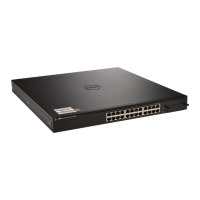Stacking Dell PowerConnect Switches: 8132, 8132F, 8164, 8164F
7
Stacking and management
An important advantage of stacking is that it provides a consolidated interface for management of
multiple switches that are linked together. One switch acts as the Master, and the entire stack is
managed through the management interface (Web, CLI, or SNMP) of the stack Master. After a stack is
deployed in the network, operators can easily add units to the stack as their port requirements
increase, with minimal administrative overhead. Additional stack members can immediately use
existing configuration information such as routing and switching configurations, VLANs, ACLs, port
profiles, and security certificates.
Simplified firmware updates for stack members
When switches are stacked, only the Master needs to be updated with new firmware. All members of
the stack receive the firmware from the Master at the same time it is being updated, minimizing the
administrator’s time used for updating firmware. Also, when a switch is added to a stack, if it is
running a different backup version of firmware than the active version on the stack Master, the backup
firmware on the new member is automatically updated to match the Master, the backup version of
firmware on the new member is activated, and the new member is rebooted.
Stacking and redundancy
By connecting a cable from the last switch in a stack back to the first switch, the operator makes sure
that a stack has the protection of redundant paths for control and data traffic, including support for
Link Aggregation Group (LAGs) configured across multiple switches. This means that any single point
of failure (a switch or a stack cable failure) does not affect the overall operation of the remaining stack
elements.
Nonstop forwarding on the stack
The Nonstop Forwarding (NSF) feature allows the forwarding plane of stack units to continue to forward
packets while the control and management planes restart as a result of a power failure, hardware
failure, or software fault on the stack Master and allows the standby switch to quickly takeover as the
Master.
Hot add/delete and firmware synchronization
Units can be added and removed to and from the stack without cycling the power on the stack. When
adding a unit, the Stack Firmware Synchronization feature automatically synchronizes the firmware
version with the version running on the stack Master. The synchronization operation may result in
either an upgrade or a downgrade of firmware on the mismatched stack member. In addition, the
running-config on the member is updated to match the Master switch. The startup-config on the
standby and member switches is not updated to match the Master switch. The hardware configuration
of every switch is updated to match the Master switch (unit number, slot configuration, stack member
number, and so on).
Meta-data considerations
When creating a stack, the configuration information is meta-data that is part of the hardware
configuration applied at boot time before the switch firmware is started (and before the startup
configuration is read). The stack information shown in the startup and running configurations is simply

